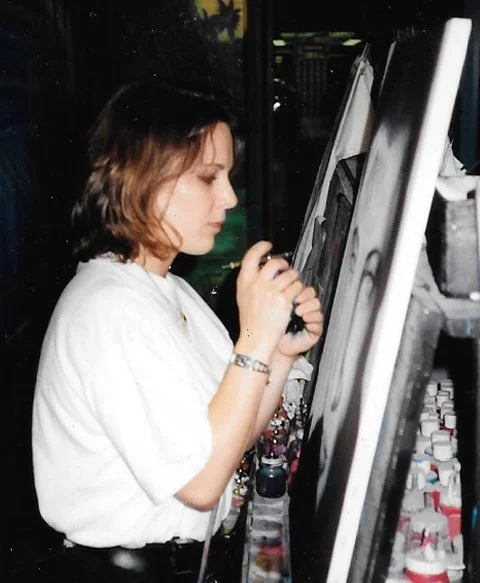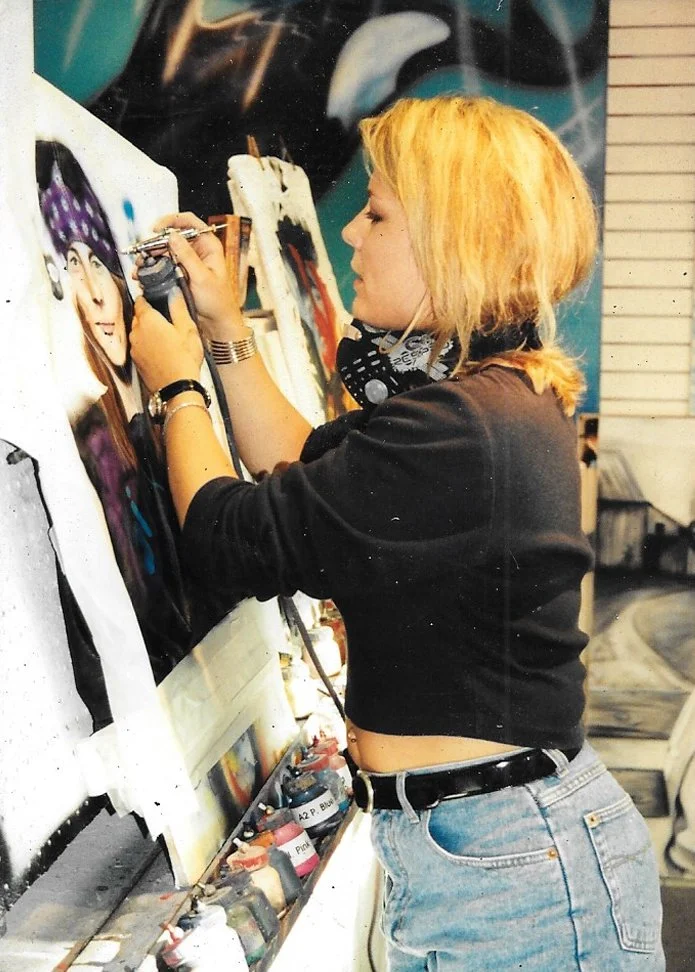This is one of those questions that is difficult for artists to find the answer, or at least an answer that is “one size fits all”. This is because there is no such thing, since “art is subjective” so is the price of the art and so there can not be a formula that covers every artist.
As a courtesy heads up before you read further we wanted to let you know that while we are a full service “Airbrush studio”, that does everything from t-shirts to murals and fine art canvases to teaching classes, we are writing this post from a more “custom art” point of view for artists that produce custom artwork that they are generally selling the originals. This can range from high end/detailed custom t-shirts, crafts, canvas paintings even murals and pretty much anything that is a one of a kind original.
There are many factors that go into making money as an artist. For example, some artists sell prints of their original work at drastically lower prices than the original. Some artists take on “commissions” and produce artwork for clients directly. Some artists sell their art produced on other products like apparel, pillows, clocks, stickers, phone cases etc... It’s money from these various avenues that also help artists make a living selling art. These things may also effect how much they charge for original art. For example, if a single piece of art is making you a lot of money being reproduced on t-shirts, mugs, prints etc… then the original painting itself will be worth a lot more than one that does not sell as well in those other avenues.
So while reading this, keep in mind that there is no one way that you can make money from your art and this post will NOT give you any one answer or formula that will automatically give you the direct, fool proof, definitive way to do so. This post will give you the information and guidelines you need to create your own formula that will work for you and your situation when it comes to what goes into determining the price of a single, one of a kind piece of art.
To start, for an artist there is no possible way you can know how many paintings or other pieces of art you are going to sell each year or even from show to show, gallery to gallery etc… and therefore there is no way of knowing how much money you are going to make each week, month, year. Nobody is paying you a standard “Salary”. You do not know from day to day if you are even going to sell anything. So you have to keep this in mind when pricing your work. The painting you create today many not sell for weeks or months or longer. It’s more about “investing” in yourself for future gains. Over time you will have a fairly good idea of what you might expect to make simply by experience.
As we said above, nobody is paying you a weekly salary so you don’t really know how much you make each year until the year is over. Where as someone with a full time job pretty much knows what they will make from week to week month to month. However, here is something to keep in mind. At the time of this writing,(December 2022) the average “fine artist” is said to earn about $26.00 an hour.(for simplicity sake we are going to round down to $25.00 for the rest of this post) This information was gathered by various blog posts, articles and forums. Which when you think about it in depth it’s not all that great. However it is a good starting point for you to consider when starting out. Keep that $25.00 an hour in mind as you read because we will be using this figure later on.
The thing that most people will tell you needs to be considered when trying to figure what to charge is your cost of supplies, time invested, overhead costs such as rent, utilities, business insurance…etc. and while this is part of it, it’s not all of it and not the most important part.
Time…will also be a determining factor. It’s going to take time to get used to knowing what you should be charging. Over time you will learn by trial and error what price points sell best. This may change from show to show, area to area, painting to painting, client to client. You are not going to get it correct as soon as you are done reading this. It will take time, observation and flexibility to get to the perfect price point for your work, but you will eventually arrive at a “formula” that works best for you. So be patient as you work your way through this aspect of being an artist.
The biggest obstacle most artists have to over come when determining prices is to accept one fact that we all seem to try and hide from…which is… ”YOU ARE A BUSINESS”. Learning how to separate our “artistic self” from our “business self” is one of the most difficult things for an artist to do” Which is why many artists turn to agents and other business professionals to help with this side of being an artist. Artists think that if they sell anything, no matter for how much, that they did great. Some jump at the chance to sell an original painting for way less than it is actually worth simply because their cell phone bill is due. Never mind that they won’t have anything left over to put away or to put back into the business. All they care about is the fact that someone wants to buy their art at that moment that will cover the cost of their phone bill. This is an impulse that a lot of artists share and is a costly habit to get into…..we call it “Impulse selling”
What you need in pricing your work is confidence in yourself and your work and the self respect needed to demand that you get what you DESERVE for your artwork(within reason). The quality of the work will speak for itself. The problem is that most artists see the art in a completely different way than any “potential” client/customer. This is not a good thing because most artists view their artwork in a more negative way than the average person. Most artists HATE their work…lol…which is just stupid. They don’t try to see their work from a potential buyers point of view.
So #1 in determining price is have Confidence and self respect. Believe in yourself and the work you are creating.
“Art is Subjective”….we have all heard this statement. If you haven’t, allow me to elaborate. What this means is that Art is “Subject” to personal opinion. Which means that what YOU like someone else may not like and vise versa. Just like “Beauty is in the eye of the beholder”…so is art. Some people will look at a piece of art and think it is “beautiful” and some will look on it as a piece of trash.
So how do I know if my work is “beautiful”? The honest answer is you will NEVER truly know….because “Art is Subjective”. which is why it is so totally stupid but true that artists are their own worst critics. As an artist you will ALWAYS think your work can be better. But your opinion about your work does not matter…it’s your client or customer’s opinion that matters.
So, #2, in determining what to charge is to compare your work to those around you doing the same type of work. What are those other “artists” that are doing work similar to yours charging? However, to get this answer you have to be honest with yourself and your work. Which means you really have to seek out other artists that are doing work that is not only similar in subject matter, medium, size, style but also in quality. Other things to keep in mind are…
•where they are located
•how much experience do they have
•how often do they produce new work etc…
All this info goes into helping you to determine price. The problem is that artists have a hard time finding artists that are similar to them because they either do not want to admit that they are as bad or as good as the artists they find in this search. Get over it, open your eyes and LOOK at the work as compared to yours. Leave all your emotions out of it and just LOOK at the work with an open mind. If all else fails, you can also ask people you trust to give you an honest opinion as to whether or not the work of a particular artist you find is similar to yours. But you need to be honest with yourself.
So how does all this relate to pricing your art? Let’s look at a simple example. Pretend that you are a landscape artist just starting in your art career somewhere in the Mid-west. You can usually paint 1 piece of work a week. It would be foolish of you to expect to be able to charge the same as a landscape artist in New York City with similar work that has been painting for 20 years and produces new work every few days. You want to have confidence in your work but you also need to be realistic. All the contributing factors that go into determining what you should charge will be completely different than the artist in New York city. Their supplies will cost them more, their overhead will cost them more, their over all cost of living will be completely different than an artist from the midwest.
So here is where we stand so far in the determining factors of what to charge:
#1 Self Confidence, Self Respect in yourself and your work.
#2 Compare your work to similar artists.
This brings us to #3 which involves taking into consideration all the practical, every day, business related things such as:
• production time(how long did it take to do each painting
• cost of supplies(which for most artists are relatively small….but still very important)
• overhead expenses such as rent, utilities, insurance, advertising costs, travel, show fees etc…
Let’s see what happens if we take the $25.00 an hour wage as mentioned above and add it into the scenario mentioned of the new mid-west landscape artist. Let’s say that a 24”x36” stretched canvas landscape painting that they just completed, took them 6 hours from beginning to end. Let us also assume that they are paying themselves $25.00 per hour as the “average” indicated above. Let’s break this down by looking at the contributing factors by cost. Again, this will all vary from artist to artist mainly because of location.
1.) cost of supplies: about $45 for the canvas, paint, brushes etc..(for this one painting)
2.) overhead(daily average of rent, utilities, insurance and other expenses)..lets say that their monthly overhead adds up to $1500.00 a month. Divided by 30 days = $50 a day. So this is telling you that it is costing them $50 a day to maintain a studio to work from….even if they are working from home.(which by the way is a tax deduction, but that is a whole other subject).
So as of right now it has already cost the artist $95.00 to produce one painting in one day before they even pick up a paint brush ($45.00supplies + $50.00 overhead) =$95.00
3.) Time…6 hours to complete the painting from beginning to end. 6 x $25 per hour(average salary as indicated above) =$150.00
So, all total we have $45(cost of supplies) + $50(overhead) + $150(their salary…$26.00 X 6 hours)for a total of =$250.00 This is the TOTAL that it cost that mid-west artist to produce that one painting only if they are paying themselves $25.00 an hour. So, how does $250.00 for 6 hours of work(which comes out to be about $42.00 per hour) sound? I’ll bet it sounds pretty good…however this is NOT how much they are actually making and is NOT what they should sell the painting for. If they did then they only made $25.00 an hour($150.00) because the rest of the $250.00($95.00) were the expenses that they had to pay for to produce the painting. Had they not added in some kind of “salary” then they would not have made anything.
Let’s try the above scenario again with a little twist… Realistically the amount of paintings that each artists produces will vary from artist to artist. You may be producing more than one painting a day or you may only produce 1 painting a month. If you produce one painting a month using the same information above, let’s see how that adds up….
1.) $45(cost of supplies)
2.) overhead for the entire month $1500.00($50.00 a day X 30 days)
3.) $25.00 an hour for 6 hours a day for let’s say 5 days a week which would be 30 hours a week times 4 weeks = 120 hours a month of actual work on one painting. Now take 120hours X $25.00= $3000.00. This would be how much the artist added into the price of that one painting to give themselves a “Salary”
So…. $45.00+$1500.00+$3000.00=$4545.00 would be the cost of producing 1 painting a month. if you pay yourself $25.00 an hour. Can you sell that painting for $4545.00?. It might be hard for some but for others it won’t be a problem….eventually.
This will also vary from what a midwest artist’s “overhead expenses" are verses a New York City artist’s expenses. If the Midwests artists overhead is $1500.00 a month then surly a NYC artist’s overhead would almost double. So this will effect the price of that painting.
Hopefully you can see by the above examples how there are so many different factors that effect each artist in a different way. Hence the reason why there can never be a “one size fits all” pricing guide.
So #4 of things to consider when deciding on your pricing is to “add in some kind of Salary” which basically is something above and beyond what it cost you to produce the painting(supplies, overhead etc..)
But we are not done yet. When pricing your art, the most important factor that needs to be added into the price is PROFIT!….you need to sell your art for MORE than it cost you to produce it.
So #5 on the things to consider when pricing your art is “PROFIT” .
This is how you make a living and grow your business. Salary and Profit are NOT the same thing. If you are the landscape artist mentioned above, the $25.00 an hour that you figured into the cost of the painting as your “Salary” is actually an expense in the production of that painting. Your Profit is what is left over after all the expenses are paid….including your salary. This is where “YOU ARE A BUSINESS” comes into play and where most artists fail to separate themselves from the business. Artists look at the $150.00($25.00X6hrs) that they “paid themselves” and think. “I made $25.00 an hour….I’m rich!”…lol
However, here is your wake up call. The “average” $25.00 an hour salary for a “fine artist” was arrived at by adding up all the income of many different artists from all the paintings they sold over the course of a year. Then taking out the expenses of supplies, overhead, etc…and taking what was left over and divided by the typical 40 hour a week job. This is how they came up with $25.00 and hour as an “average of what a Fine Artist makes hourly….yearly that comes to $52,000.00 Obviously some made more and some made less. However, YOU as an artist do NOT work a typical 40 hour work week. You will NOT be making a standard amount each week….AND….you have expenses that you spend money on in order to arrive at the average $25.00 per hour. In other words it actually COSTS you money in order to MAKE $25.00 an hour. Where as someone else working a different type of job making $25.00 an hour is actually bringing home $25.00 per hour. This is why it is so important to take EVERYTHING into consideration when pricing your art.
The truth is, it could very well be that one of the artists in the study that arrived at $25.00 an hour as an average for fine artists might not have sold a single painting all year until December when all of a sudden they sell one for $50,000.00. So how did they make money the rest of the year? How did they live from week to week? Day to Day from January thru November?…this is where Salary and PROFIT come in.
You are NOT going to sell ALL your paintings each day. You will probably have dozens if not hundreds of paintings lying around the studio unsold for months if not years. So how do you distinguish between your salary and profit? and how do you know what each of those should be? How much do you want to make verses how much do you want your “business” to make? This is what will vary from artist to artist based on each individuals expenses and lifestyle.
As with the example above, the first thing to remember is $250.00 is only covering that landscape artist’s expenses which includes how much they are paying themselves for the time spent working on that one painting. It is NOT giving them any “profit” to grow their business. All the $250.00 showed you was how much producing one painting was realistically costing. Now that artist has to determine how much on top of the $250.00 do they want to be able to put back into their business to help it grow. This is the money that might help pay their bills when none of their work is selling. It is the money that will go into savings and will help them with growing their business.
When determining profit, you need to keep one thing in mind “ Profit is NOT your Salary and Salary is NOT your profit. They are two separate things and should be considered separately when figuring your price for an original piece of art. For simplicity sake we are going to stick with the $25.00 hr figure as our Salary. Which means all of the work we produce will be charged at $25.00 per hour. Again, this is just an example. You may feel you deserve more or you may feel you should start a little lower for your art. This is where “Time” will come into play as over time you will see how your work sells with this price formula.
What follows will just be ONE example of how you can determine what to charge. YOU will determine whether it is enough or not and will adjust according to your own circumstances. This will be the hardest part for you as an artist because it is going to involve separating your artistic self from your business self. This will take Self Discipline which is another thing that many artists lack.
Let’s take the painting from the above example that took the new artist 6 hours to complete. The final cost of that painting up to this point was $250.00 which we got by adding together all the “expenses” which included the $25.00 an hour Salary. The Salary part came to be $150.00. Now we need to add in some profit. Since 15%-20% is the standard “norm” when it comes to the “service” industry and in businesses such entertainment/talent representation and even in galleries and art representatives, we are going to use this as our way of determining our Profit.
We are going to take 20% of the $250.00 which comes out to be roughly $50.00 and add that onto the price of the painting to make the total cost $300.00. So that one original painting will have a final price tag of $300.00. That’s $250 X 20%=$50…so $250.00+$50.00=$300.
Now the hard part of being an artist…..Self Discipline.
When that one painting sells for $300.00 what do you do with the money? Inexperienced artists will just take it all and put it into their personal bank account. Why?….because they never opened a separate “business bank account”. Some, that were smart enough to separate their personal account from their business account might take out the $95.00 in supplies and overhead cost and put that into a “business account” and put the rest in their personal account. But the correct answer…if you have enough self discipline.. is to take the “Salary” amount, which in this case was the $150.00 and put this in your personal account and the rest which is made up of the expenses of supplies and overhead along with the profit and put it into your business account.
So # 6 on determining pricing is to open a separate business checking and savings account.
You should consider yourself an “employee” of your “Business” and your Business should pay you. That is what the “salary” is. It is the money you should be able to live off of and pay all your personal expenses. The profit and “expense” money should go back to the business so that you have money to keep the business growing. This way you will always have money to buy supplies and do advertising and take business related trips or anything else that your business needs to continue and to grow.
Some may even take it a step further(which is wise) and divide the “salary” money into a personal checking and savings so they also have personal savings to fall back on when things are slow. Others may use money from the “business” account and “take out a loan” sort of speak when times are slow and replace it when times are better.
How you use the money when your work sells is up to you and everyone will have their own opinion of what to do with it.
So as a re-cap, here are the 6 things to remember when pricing your art.
#1) Self Confidence, Self Respect in yourself and your work.
#2) Compare your work to similar artists and see what they are charging for artwork that is similar to yours.
#3) Take into consideration all the practical, every day, business related things such as:
• production time(how long did it take to do each painting
• cost of supplies(which for most artists are relatively small….but still very important)
• overhead expenses such as rent, utilities, insurance, advertising costs etc…
#4) “add in some kind of Salary” which basically is something above and beyond what it cost you to produce the painting(supplies, overhead etc..). You can decide that this is an hourly amount or you may decide that ALL your paintings will have a set amount that gets added in to each painting. There really isn’t a wrong answer so just experiment.
#5) PROFIT….add in an amount above and beyond the Salary and expenses. This could be a percentage as in our example of 15-20% or it can also be a flat amount.
#6) get a separate business account.
One other last thing to keep in mind. There are two rules taught in businesses 101 classes.
1.) You can make money by selling MORE for LESS… or …you can sell LESS for MORE.
Both of these selling methods are going to make money when it comes to art. In simple math terms, you can paint 10 paintings in a day and charge $10.00 each and make $100.00(working more for less)… or… you can paint 5 paintings in a day for $20.00 each and make the same $100.00(working less for more)
2.) Supply and demand. If your work sells out at every show you attend which forces you to work your butt off creating NEW work before the next show. Then you are working harder because your prices are low. If you work is that popular than raising your prices will not effect the popularity of your work. Simple Supply and demand….when demand is high, prices are high, when demand is low, prices are low. Raising your prices MIGHT give you less sales but you will be making the same amount of money and possibly even more…but you might have a few pieces of art left over and not have to work as hard creating work for the next show.
Vise Versa, if you attend a show again that you didn’t do as well at last time then possibly, at that show, your prices may be to high for the clients you are being exposed to, so you might lower your prices and see how things sell….when demand is low, prices are low.
Hope this helps with the age old question of “What should I charge?” As always please leave any comment or questions and please be sure to follow our social media… especially our facebook page @anythingairbrushed that was hacked back in 2021 and we lost almost 2000 followers.











